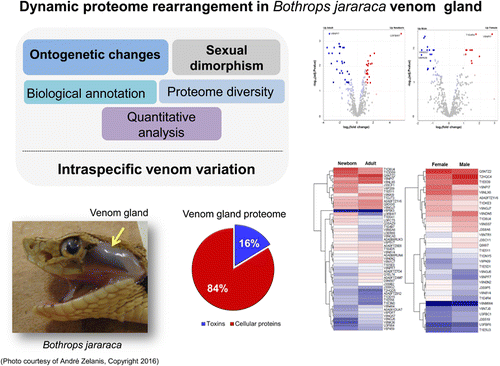Snake venom composition could be related to hormones and diet

Many people are afraid of snakes, but scientists are now revealing insights about their venoms that could give even ophidiophobes an appreciation for the animals. One team has found that the proteins from the venom gland can vary depending on age and gender. These findings, reported in ACS' Journal of Proteome Research, suggest that hormonal and dietary influences are at play.
Among the animals that can instill immediate fear in passers-by, snakes rank fairly high. They are stealthy and can strike quickly with precision. Many can inject victims with a nasty poison. Scientists have already found that venom composition varies between and within species. André Zelanis and colleagues wanted to conduct a precise protein profiling of the gland where the toxin is produced to find out more information about this variation.
The researchers analyzed venom from infant and adult snakes, both male and female, of the poisonous species Bothrops jararaca, a well-studied South American snake. Between the infants and adults, about 8 percent of the venom gland protein profiles differed. And the type of toxins expressed in the infants' glands were dominated by a different type than that dominating the adults' toxins, which could help the animals shift their diet from small reptiles and amphibians to mammals. The venom gland proteomes of males and females differed by almost 5 percent. The study's findings could indicate that hormones associated with either aging or gender play a role in what's in a snake's venom, the researchers say.
More information: César Augusto-de-Oliveira et al. Dynamic Rearrangement in Snake Venom Gland Proteome: Insights intoIntraspecific Venom Variation, Journal of Proteome Research (2016). DOI: 10.1021/acs.jproteome.6b00561
Abstract
We carried out an analysis of the venom gland proteome of Bothrops jararaca taking into account two distinct phases of its ontogenetic development (i.e., newborn and adult) and the marked sexual dimorphism recently reported on its venom proteome. Proteomic data analysis showed a dynamic rearrangement in the proteome landscape of B. jararaca venom gland upon development and gender-related changes. Differentially expressed proteins covered a number of biological pathways related to protein synthesis, including proteins associated with transcription and translation, which were found to be significantly higher expressed in the newborn venom gland. Our results suggest that the variation in the expression levels of cellular proteins might give rise to an even higher variation in the levels of the expressed toxins. Upon aging, the venom gland proteome repertoire related to the protein synthesis together with ecological traits would have an impact on the toxin repertoire, which, in the case of B. jararaca species, would enable the species to deal with different prey types during its lifespan. Proteomic data are available via ProteomeXchange with identifier PXD004186.
Journal information: Journal of Proteome Research
Provided by American Chemical Society





















